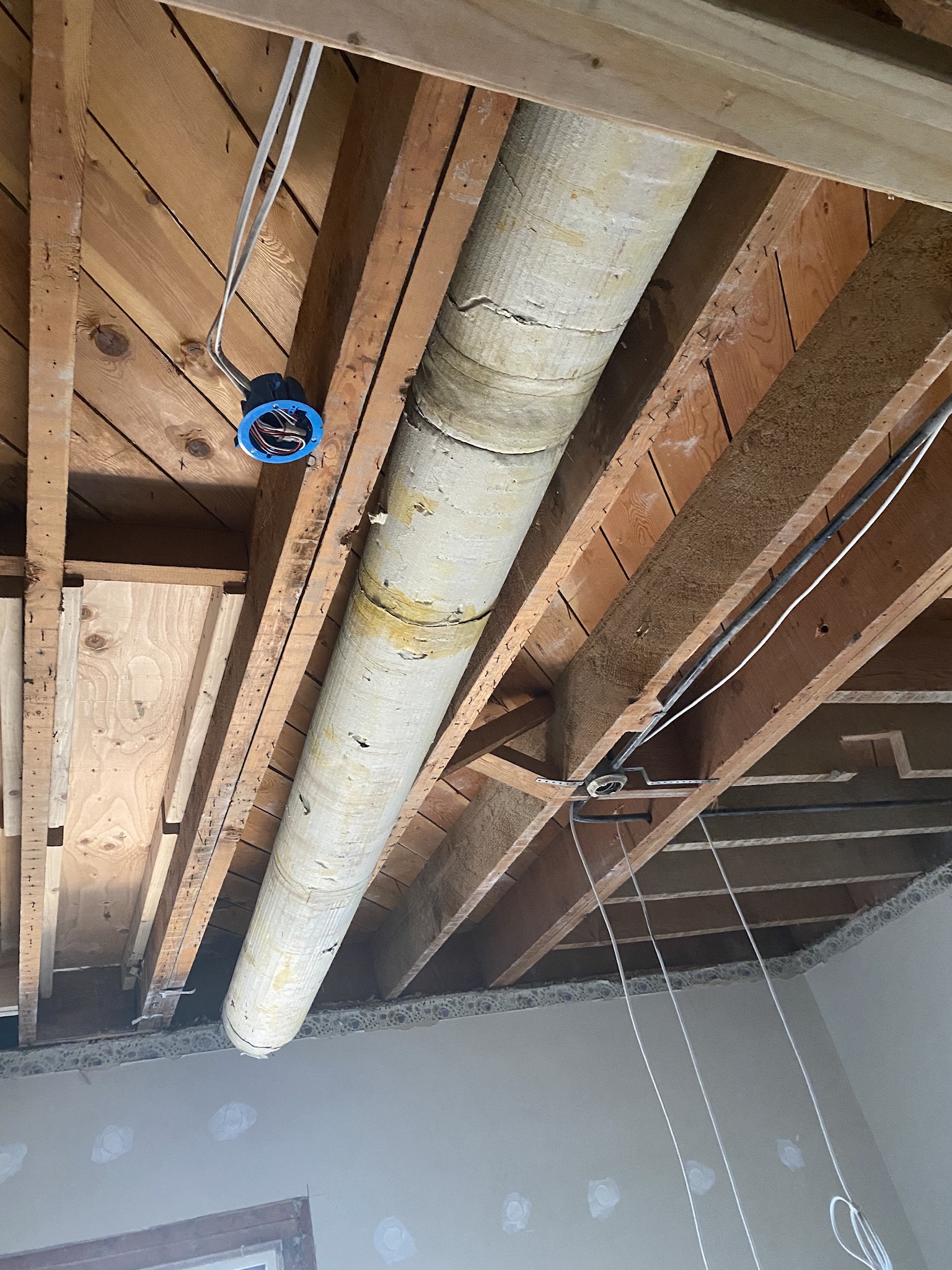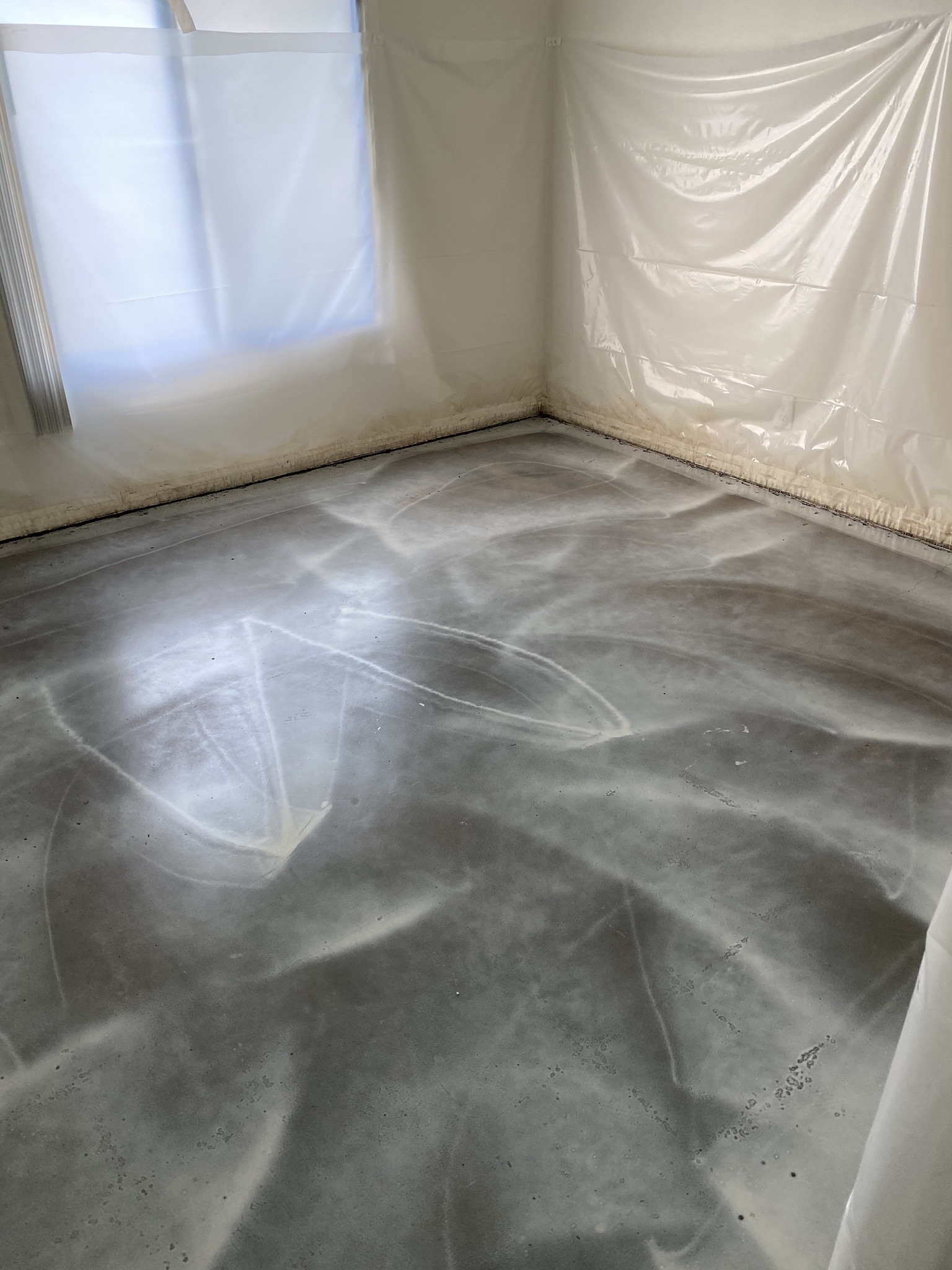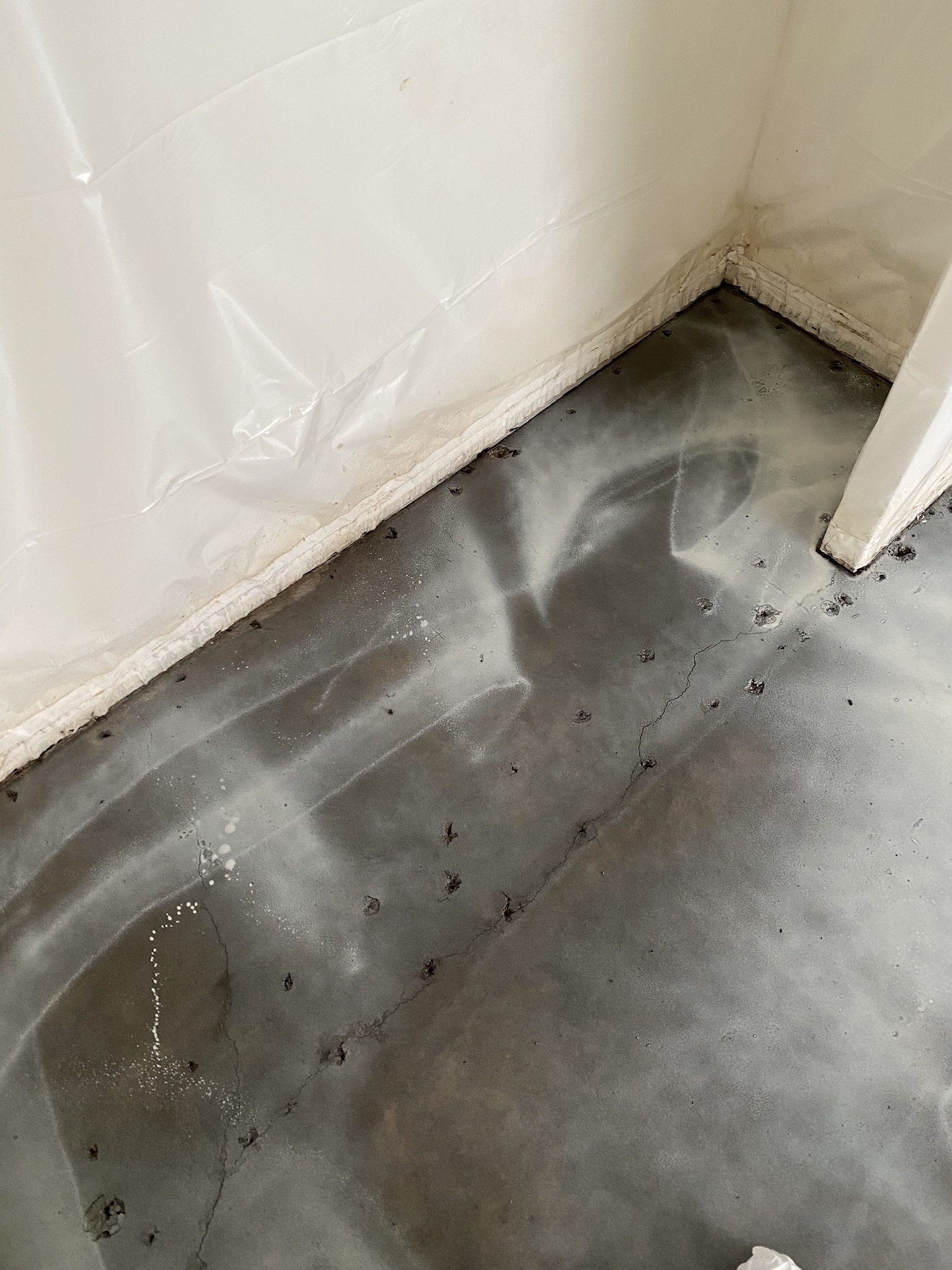


when asbestos is verified by a licensed Hygentist, the remediation company takes dust control very seriously and wraps the rooms they will be working in , in a 6mm plastic yo contain any asbestos fibers from escaping which could contaminate the area not wrapped.
TOP 20 ASBESTOS QUESTIONS
1. How do I know if I have asbestos in my home (in floor tile, ceiling tile, shingles, siding, etc.)?
The only way to be sure whether a material contains asbestos is to have it tested by a qualified laboratory. EPA only recommends testing suspect materials if they are damaged (fraying, crumbling) or if you are planning a renovation that would disturb the suspect material. Samples should be taken by a properly trained and accredited asbestos professional (inspector).
2. What are the health risks if I have asbestos in my home, building, apartment, or school?
3. Where can I find someone to remove the asbestos in my home?
You can perform an internet search for “asbestos contractor” and the location of your home. Contact your state to determine what state training and accreditation requirements may exist for both the contractor and their workers. EPA recommends that you use an asbestos contractor that is properly trained to handle asbestos.
4. My attic has vermiculite insulation in it. Am I at risk? Should I take it out?
If you have vermiculite insulation in your home, you should assume this material may be contaminated with asbestos and be aware of steps you can take to protect yourself and your family from exposure to asbestos. The EPA recommends that vermiculite insulation be left undisturbed. Airborne asbestos fibers present a health risk through inhalation, so the first step is to not disturb the material, which could release fibers into the air. If you disturb the insulation, you may inhale some asbestos fibers. The degree of health risk depends on how much and how often this occurred. If you choose to remove the vermiculite insulation, this work should be done by a trained and accredited asbestos abatement contractor that is separate and independent from the company that performed the assessment of the vermiculite insulation to avoid any conflict of interest.
5. I am thinking about buying a house but it has vermiculite attic insulation in it. Should I have it removed before or after I buy the house?
Removal of the vermiculite insulation may not be necessary if it is confined in a manner where it will be left undisturbed. If you choose to have the vermiculite insulation removed, the EPA recommends that you use a trained and accredited asbestos contractor that is separate and independent from the company that performed the assessment of the vermiculite insulation to avoid any conflict of interest.
Asbestos that is in good condition and left undisturbed is unlikely to present a health risk. The risks from asbestos occur when it is damaged or disturbed where asbestos fibers become airborne and can be inhaled. Managing asbestos in place and maintaining it in good repair is often the best approach.
2
6. I use/used vermiculite to enhance my potting soil. Should I be concerned?
EPA’s investigation (see report) into these products indicates that consumers face only a minimal health risk from using vermiculite products at home or in their gardens.
To further reduce the risk associated with the occasional use of vermiculite products during gardening activities, EPA recommends that consumers:
• Use vermiculite outdoors or in a well-ventilated area.
• Avoid creating dust by keeping vermiculite damp during use.
• Avoid bringing dust into the home on clothing.
Although EPA does not endorse the use of any particular product, consumers may choose to use:
• Premixed potting soils, which ordinarily contain more moisture and less vermiculite than pure vermiculite products and are less likely to generate dust.
• Soil amendment materials other than vermiculite, such as peat, sawdust, perlite, or bark.
7. How do I get certified as an asbestos professional?
To become a properly trained and accredited asbestos professional you will need to seek training from a training provider that offers courses approved by the EPA or a state to conduct asbestos training pursuant to the Asbestos Model Accreditation Plan. Most states also require a license to perform this work. Your training course completion certificate is a general prerequisite to applying for such a license. The training courses vary in length from 2 to 5 days depending upon the type of work you wish to perform. Accredited asbestos training courses are offered in five separate disciplines; Asbestos Abatement Worker, Asbestos Abatement Supervisor, Inspector, Management Planner and Project Designer. Some states may refer to these training disciplines by different, yet similar names.
8. Where can I find someone to test a material to see if it contains asbestos?
You can perform an internet search for “asbestos inspection and assessment” and the location of your home. Also, make sure that the inspector is properly trained and accredited by your state.
9. I’m remodeling my home. Do I need to be concerned about asbestos in the building materials?
It’s not possible for you to tell whether a material in your home contains asbestos simply by looking at it. If you suspect a material within your home might contain asbestos (for example floor tile, ceiling tile or old pipe wrap) and the material is damaged (fraying or falling apart) or if you are planning on performing a renovation that would disturb the material, the EPA recommends that you have it sampled by a properly trained and accredited asbestos professional (inspector). The professional then should use a qualified laboratory to perform the asbestos analysis. Also, you may
3
learn more about whether the replacement materials you intend to install might possibly contain asbestos by reading the product labels, calling the manufacturer, or by asking if your retailer can provide you with the Material Safety Data Sheet (MSDS) for the product(s) in question.
10. Since asbestos was banned, do I need to be worried about products on the market today containing asbestos?
On July 12, 1989, the EPA issued a final rule under Section 6 of the Toxic Substances Control Act (TSCA) banning most asbestos-containing products in the United States. In 1991, the rule was vacated and remanded by the Fifth Circuit Court of Appeals. As a result, most of the original ban on the manufacture, importation, processing, or distribution in commerce for most of the asbestos- containing product categories originally covered in the 1989 final rule was overturned. Only the bans on corrugated paper, rollboard, commercial paper, specialty paper, and flooring felt and any new uses of asbestos remained banned under the 1989 rule. Although most asbestos containing products can still legally be manufactured, imported, processed and distributed in the U.S., according to the U.S. Geological Survey, the production and use of asbestos has declined significantly.
11. Is there still asbestos in automobile brakes?
It is possible that some aftermarket brakes, especially imported brakes, may still contain asbestos.
12. How do I find out if my child’s school has asbestos in it?
The Asbestos-Containing Materials in Schools Rule, pursuant to the Asbestos Hazard Emergency Response Act (AHERA) requires schools to make their asbestos management plans available to the public, including parents, within 5 working days of the request. The asbestos management plan should discuss the location and type of asbestos-containing materials and any preventive measures or response actions taken in your child’s school. You can also contact the school’s AHERA Designated Person directly for more information, or if you have specific questions about asbestos in your child’s school. The AHERA Designated Person’s name and contact information appears in the management plan.
13. Was my school required to be inspected for asbestos?
Yes, unless the building architect or project engineer responsible for the construction of the school building certified in writing that no asbestos materials were used in the building’s construction. Otherwise, all public and non-profit private primary and secondary schools need to be inspected for asbestos. The results of the inspections and all re-inspections, required every three years, are contained within the schools asbestos management plan. A complete and up-to-date copy of the asbestos management plan is required to be housed in the school’s administrative office.
4
14. My child’s school has asbestos in it. Why aren’t they taking it out?
Local education agencies (e.g., school districts) are required under the asbestos-containing materials in schools rule, pursuant to the Asbestos Hazard Emergency Response Act (AHERA) to inspect for and manage asbestos containing materials properly through the development and implementation of an asbestos management plan. The local education agency can safely and effectively “manage in place” asbestos-containing materials that are in good condition. The risk from asbestos is when it is damaged and/or disturbed and asbestos fibers become airborne where they can be inhaled. If the local education agency does perform a “response action” or an asbestos abatement, they must use properly trained and accredited asbestos professionals to do this work. Local education agencies are required to undertake timely and appropriate maintenance or response actions whenever asbestos- containing materials become friable.
15. Is the school district required to do anything about asbestos in its school buildings?
Yes. The Asbestos Hazard Emergency Response Act (AHERA) was passed by Congress in 1986. AHERA requires public school districts and non-profit private schools to inspect their schools for asbestos- containing building material and prepare management plans which recommend the best way to reduce the hazard from any asbestos-containing materials that may be present. Options include repairing damaged asbestos-containing material (such as spraying it with sealants, enclosing it) or removing it. The plans must be developed by accredited management planners and submitted to the State. The school authority must notify parent, teacher and employee organizations of the plans, and then the plans must be implemented. The school district must also perform periodic surveillance of asbestos-containing material every 6 months in its schools. AHERA also requires accreditation of abatement project designers, abatement workers, supervisors, and building inspectors.
16. What is an asbestos management plan?
An asbestos management plan is required to provide documentation of the recommended asbestos response actions, the location of asbestos within the school, and any action taken to repair or remove the material. The school authority must maintain records to be included in the Asbestos Management Plan. These records include among other things:
• List of the name and address of each school building and whether the building has asbestos containing building material, and the type of asbestos-containing material.
• Date of the original and each subsequent school re-inspection.
• The plan for re-inspections, and operation and maintenance.
• A blueprint that clearly identifies the location and condition of all asbestos-containing
building material that remains in the school.
• A description of any response action or preventive measures taken to eliminate or control
asbestos exposure.
• A copy of the analysis of any building material, and the name and address of any laboratory
that sampled the material.
5
• The name, address, and telephone number of the “designated person” to ensure the duties of the local education agency (LEA) are carried out.
• A description of steps taken to inform workers, teachers, and students or their legal guardians about inspections, re-inspections, response actions, and periodic surveillance.
17. Does this management plan have to be updated periodically?
Yes. The asbestos management plan must be updated with information collected during periodic surveillance every 6 months, re-inspections every 3 years, and every time a response action is taken within the school. Also, records of annual notifications to parents, teachers, and staff concerning the availability of the school’s asbestos management plan must be included within the asbestos management plan files.
18. Does my school district know where the asbestos in its school buildings is located?
They are required to know and to describe where the material is located in the asbestos management plan, and also to monitor and record any change in its condition that might pose a potential safety risk.
19. How can we have the air tested in my school?
AHERA only requires air testing following an asbestos response action (e.g., asbestos repair or removal activity) to determine whether the activity has been properly completed. This is done by measuring the amount of asbestos in the air where the asbestos response action took place, and is referred to as “clearance.” However, the local education agency, e.g., the school district, may hire a qualified consultant to test its air at any time, as may be needed or appropriate.
20. Is it dangerous to have asbestos containing material in my school?
Not necessarily. Undamaged asbestos that is properly managed in place poses little health risk to students, teachers and other school occupants. However, it is important that the proper school designated authorities regularly inspect the condition of asbestos-containing materials to ensure they remain intact. Asbestos can pose a health hazard when it is disturbed and asbestos fibers become airborne where they can be inhaled. Undamaged non-friable asbestos is best left undisturbed and managed in place. If done improperly, removing asbestos has the potential to create a greater health risk than leaving it undisturbed.
ASBESTOS IN THE HOME
1. Does a home seller have to disclose to a potential buyer that a home contains asbestos? What about vermiculite?
Federal law does not require the seller to disclose to a buyer that their home contains asbestos or vermiculite. State or local requirements may require disclosure. Contact your state about such requirements.
6
2. Does the EPA have money available for homeowners to
